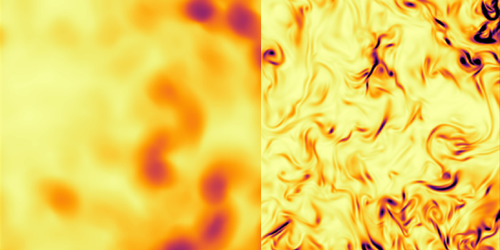• Physics 17, s45
The verification of a 63-year-old hypothesis indicates that nonequilibrium statistical mechanics could act as a theoretical framework for describing turbulence.
Turbulence involves the transfer of kinetic energy in a fluid from large vortices, down through smaller ones, into heat via viscous dissipation—the transformation of shear stress within a fluid into heat. In 1962 Russian mathematician Andrey Kolmogorov refined that description so that it accounted for the random nature of the energy transfer between length scales. Now, in a computer simulation, Hanxun Yao of Johns Hopkins University, Maryland, and his collaborators have verified that this model, which became known as Kolmogorov’s refined similarity hypothesis (KRSH), can be applied directly to the transfer of energy between scales [1]. In doing so, they have established a link between two physical concepts that embody disorder: turbulence and entropy.
Before the formulation of KRSH, below a certain length scale, velocity fluctuations in a turbulent fluid were thought to depend only on the average rate of viscous dissipation. Kolmogorov recognized that although dissipation on small scales is isotropic, it’s also strongly intermittent. Because of intermittency, an accurate description of turbulence at small and medium length scales should spatially average the local energy dissipation over a sphere with a volume relevant to that scale.
To test the validity of KRSH, Yao and his collaborators analyzed large-scale, high-resolution simulations of a strongly turbulent liquid from the Johns Hopkins Turbulence Database. They calculated the average behavior of the fluid inside 2 million randomly distributed spheres of various radii. Occasionally and not unexpectedly, energy cascaded “uphill”—that is, from smaller scales to larger ones. However, Yao and his collaborators were surprised to discover that even uphill cascades obeyed KRSH. What’s more, an uphill cascade indicates a negative energy dissipation rate, which breaks the second law of thermodynamics. The law only applies to equilibrium systems, which suggests the need for nonequilibrium thermodynamics to describe a turbulent system. That finding establishes a connection between entropy and turbulence and suggests a path toward a unifying approach to study turbulence and nonequilibrium thermodynamics.
–Charles Day
Charles Day is a Senior Editor for Physics Magazine.
References
- H. Yao et al., “Forward and inverse energy cascade in fluid turbulence adhere to Kolmogorov’s refined similarity hypothesis,” Phys. Rev. Lett. 132, 164001 (2024).



